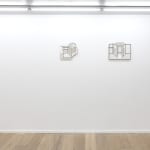

Peter Depelchin
The four scale models “Temple de Pan” I to IV are autonomous 3-dimensional drawings as well as models for a larger theatrical setting. Prior to this cycle is an ongoing series of meticulously drawn spaces on the precious Japanese Gampi Torinoko paper. As the preliminary series these four wooden models approach the depicted space in a way that it transcends the flat design of the composition. Peter Depelchin is convinced that depending on how space is conceived in an image, it adds symbolic meaning to the narrative and to the image itself. In the biggest part of his oeuvre Depelchin literally examines this relationship between representations of space and meaning beyond the represented, often accorded to the narrative. This conceptual series, however, leaves out the narrative and focusses on the mechanisms of the depicted space. Here, Depelchin forces the drawing out of its flattened space in order to duplicate the effect of the represented architectural composition.
The compositions themselves were inspired by Iranian and European medieval miniatures. At the very beginning lies a series of 180 small sized studies (each appr. 8*5 cm) based on art historical examples of that type.
- X
- Tumblr





